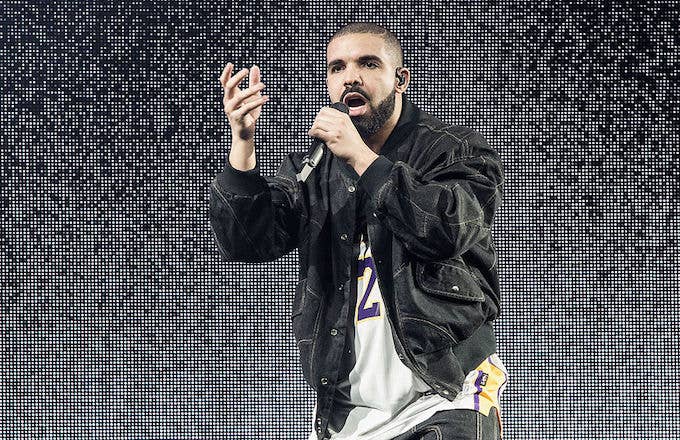
The answer to the question “Kiki, do you love me?” appears to be a resounding “Yes.”
The viral dance challenge started by Instagram star Shiggy for Drake’s Kiki interrogation “In My Feelings” has been adopted by everyone from Leslie Jones to Will Smith, pushing the bounce-flavored song to the forefront of the pop culture conversation, and to number one on the Billboard Hot 100 chart. Even Drizzy himself acknowledged that Shiggy’s dance challenge played a major part in making the track a hit.
But just howbig a part did Shiggy play? Well, between when the initial video was posted on June 29 and the middle of July, people tweeted about the song or the challenge over 2.3 million times, Twitter told Complex. That’s out of a total of 7.5 million overall tweets about Drizzy—a significant amount of his total Twitter traffic.
“Like many songs in the past few years (think #MannequinChallenge, #SoGoneChallenge, #RunningManChallenge), once a meme, challenge, or video hits Twitter, the rest is history—everyone knows the song, and it climbs the charts almost immediately,” explained Twitter’s Siobhan Murphy.
Viral challenges have moved the needle significantly in recent years, turning new songs into massive hits and bringing long-forgotten tracks back to prominence. Rae Sremmurd’s “Black Beatles” moved up to No. 1 in the fall of 2016 after everyone from the New York Giants to non-black Beatle Paul McCartney made a Mannequin Challenge video, using the tune as their score.
One of the earliest examples of this phenomenon was in 2013, when Baauer’s “Harlem Shake” came out of nowhere to debut at No. 1 after its associated meme took off. Not coincidentally, that happened the very first week that YouTube viewing data was figured into Billboard’s Hot 100 chart. But it’s not only new songs that have benefited from the phenomenon. In May 2016, “My Boo” by Ghost Town DJs re-entered the Hot 100 for the first time in two decades after it soundtracked the Running Man Challenge.
Perhaps the clearest way to see renewed interest in these songs is to examine their Spotify plays. As the largest streaming service, Spotify serves as a great marker to track the increased interest in songs that are used in popular challenges.
A Spotify representative provided us with exclusive info that sheds light on the impact of some of the most memorable challenges in recent history. The thing that pops out most dramatically is that the songs soundtracking viral challenges are, well, viral—increases happen very quickly. Looking at songs ranging from “In My Feelings” to “Black Beatles” to Shirley Caesar’s “Hold My Mule” (used in the 2016 Thanksgiving-themed U Name It Challenge), we see that songs have a one-day increase in plays ranging from 113% for Drake’s “In My Feelings” to a stunning 2,162% for “Harlem Shake.” Yes, that’s right: On February 12, 2013, “Harlem Shake” got over 21 times more plays than the day before. The second-biggest single-day increase among the songs we looked at was a late-April 2016 jump of 731% for “My Boo” when the Running Man Challenge shot into the stratosphere.
The most dramatic increases often occur quickly, too. “My Boo” had its big jump only eight days after the challenge started, and Baauer’s big leap happened less than two weeks after the first video made its way to the internet.
Here’s the full list of one-day leaps:
- #DoThe Shiggy—"In My Feelings" by Drake
Largest one-day increase in plays was 113% on 7/13 (14 days after the first challenge video) - The Mannequin challenge—"Black Beatles" by Rae Sremmurd
Largest one-day increase was 171% on 11/8/16 (6 days after first video) - The Japan challenge—"Japan" by Famous Dex
Largest one-day increase was 240% on 3/23/18 (1 day after first video) - #UNameItChallenge—"Hold My Mule" by Shirley Caesar
Largest one-day increase was 335% on 11/18/16 (4 days after first video) - The Running Man challenge—”My Boo” by Ghost Town DJs
Largest one-day increase was 730% on 4/26/2016 (8 days after first video) - Harlem Shake challenge—"Harlem Shake" by Baauer
Largest one-day increase was 2,162% on 2/12/13 (12 days after first video)
Spotify higher-ups have noticed the trend. "Challenges have become powerful drivers in music and pop culture," said Carl Chery, Creative Director, Head of Urban Music, Spotify. "They can resurrect a 20-year-old hit and put it back on the charts, like Ghost Town DJ’s’ ‘My Boo’ or help a single reach No. 1 like Rae Sremmurd’s ‘Black Beatles’ or Drake’s ‘In My Feelings.’” And the biggest beneficiaries, artists, are likewise grateful for the bump their work gets from viral challenges—though exactly what they owe the people who make the songs go viral is a topic of contentious debate.
It is probably only a matter of time until viral challenges reach a saturation point and internet culture moves on to the next phenomenon. But right now, we live in a Golden Age of virality, where songs from all eras can soundtrack everything from the latest dance craze to, well, not moving at all, and receive a huge lift up the charts in return.
